2021 HYUNDAI IONIQ ELECTRIC wipers
[x] Cancel search: wipersPage 12 of 546

H3
Electric Vehicle
An electric vehicle is driven using a
battery and an electric motor. While
general vehicles use an internal
combustion engine and gasoline as
fuel, electric vehicles use electricalenergy that is charged inside the
high voltage battery. As a result,
electric vehicles are eco-friendly in
that they do not require fuel and do
not emit exhaust gases.
Characteristics of Electric
Vehicles
1. It is driven using the electricalenergy that is charged inside the
high voltage battery. This method
prevents air pollution since fuel,
like gasoline, is not required,
negating the emission of exhaust
gases.
2. A high performance motor is used in the vehicle as well. Compared
to standard, internal combustion
engine vehicles, engine noise and
vibrations are much more minimal
when driving.
3. When decelerating or driving downhill, regenerative braking is
utilized to charge the high voltage
battery. This minimizes energyloss and increases the distance to
empty.
4.When the battery charge is not suf- ficient, AC charge, DC charge and
trickle charge are available. (Refer
to “Charge Types for Electric
Vehicle” for details.) Information
What does regenerative braking do?
It uses the electric motor when decel-
erating or braking which transforms
vehicle motion (kinetic energy) to elec-
trical energy to charge the high volt-
age batteries. (Torque is applied in the
opposite direction when decelerating
to generate braking force and electric
energy.)
Battery Information
The vehicle is composed of a high voltage battery that drives the
motor and air-conditioner, and an
auxiliary battery (12 V) that drives
the lamps, wipers, and audio sys-tem.
The auxiliary battery is automati- cally charged when the vehicle is in
the ready ( ) mode or the high
voltage battery is being charged.
i
EELLEE CCTT RR IICC VV EEHH IICC LLEE
Page 13 of 546
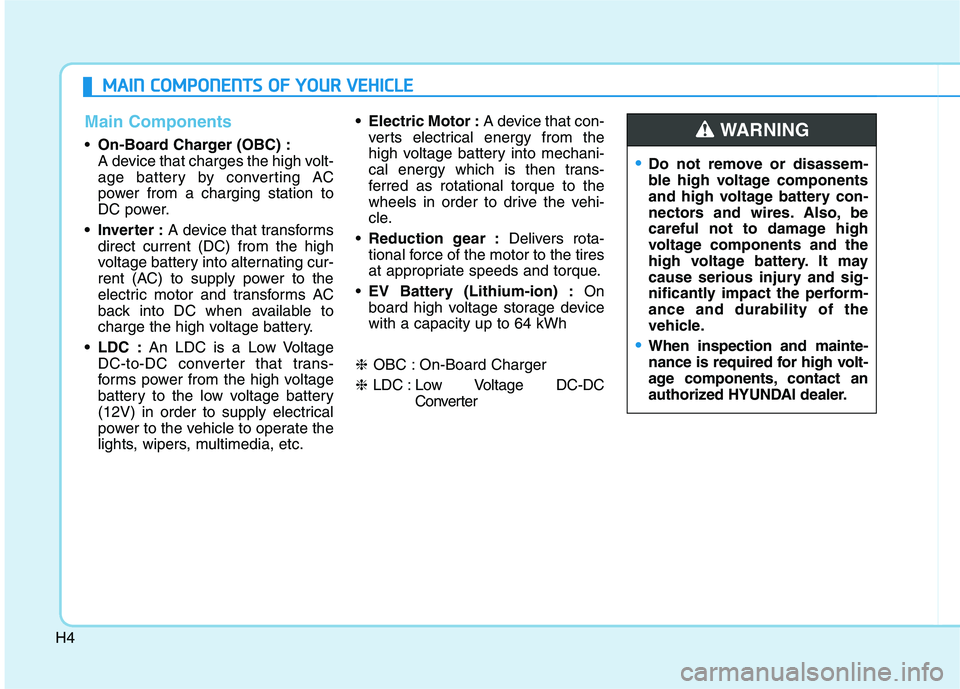
H4
MMAAIINN CC OO MM PPOO NNEENN TTSS OO FF YY OO UURR VV EEHH IICC LLEE
Main Components
On-Board Charger (OBC) :
A device that charges the high volt-
age battery by converting AC
power from a charging station to
DC power.
• Inverter : A device that transforms
direct current (DC) from the high
voltage battery into alternating cur-
rent (AC) to supply power to the
electric motor and transforms AC
back into DC when available to
charge the high voltage battery.
LDC : An LDC is a Low Voltage
DC-to-DC converter that trans-
forms power from the high voltage
battery to the low voltage battery
(12V) in order to supply electrical
power to the vehicle to operate the
lights, wipers, multimedia, etc. Electric Motor :
A device that con-
verts electrical energy from the
high voltage battery into mechani-
cal energy which is then trans-
ferred as rotational torque to the
wheels in order to drive the vehi-
cle.
Reduction gear : Delivers rota-
tional force of the motor to the tires
at appropriate speeds and torque.
EV Battery (Lithium-ion) : On
board high voltage storage devicewith a capacity up to 64 kWh
❈ OBC : On-Board Charger
❈ LDC : Low Voltage DC-DC
Converter
Do not remove or disassem-
ble high voltage components
and high voltage battery con-
nectors and wires. Also, be
careful not to damage high
voltage components and the
high voltage battery. It may
cause serious injury and sig-
nificantly impact the perform-ance and durability of the
vehicle.
When inspection and mainte-
nance is required for high volt-
age components, contact an
authorized HYUNDAI dealer.
WARNING
Page 152 of 546
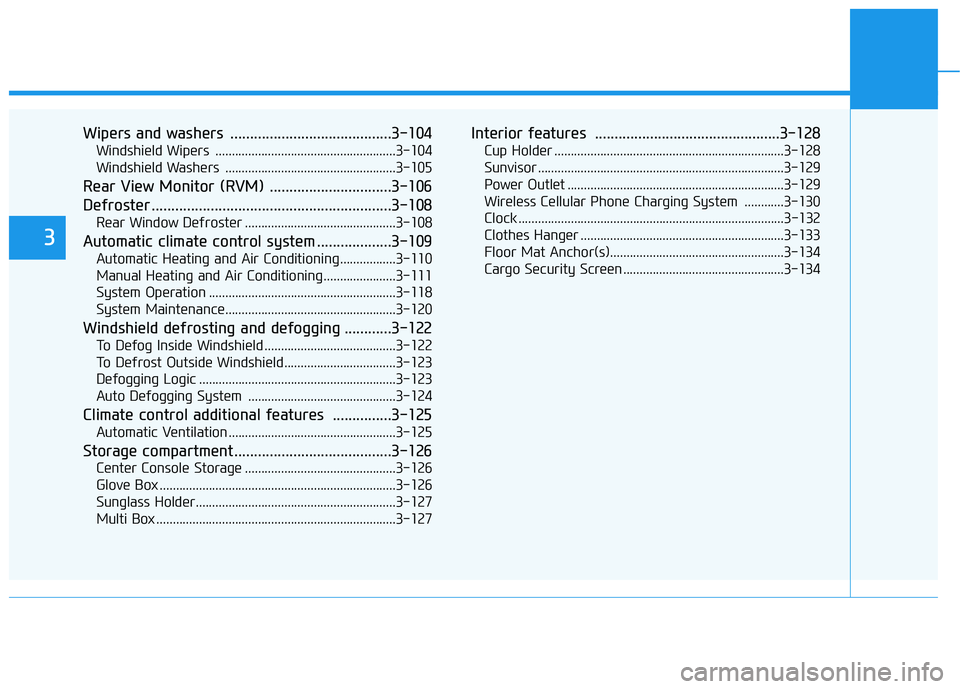
Wipers and washers .........................................3-104Windshield Wipers .......................................................3-104
Windshield Washers ....................................................3-105
Rear View Monitor (RVM) ...............................3-106
Defroster .............................................................3-108 Rear Window Defroster ..............................................3-108
Automatic climate control system ...................3-109 Automatic Heating and Air Conditioning.................3-110
Manual Heating and Air Conditioning......................3-111
System Operation .........................................................3-118
System Maintenance....................................................3-120
Windshield defrosting and defogging ............3-122 To Defog Inside Windshield ........................................3-122
To Defrost Outside Windshield ..................................3-123
Defogging Logic ............................................................3-123
Auto Defogging System .............................................3-124
Climate control additional features ...............3-125 Automatic Ventilation ...................................................3-125
Storage compartment ........................................3-126 Center Console Storage ..............................................3-126
Glove Box ........................................................................3-126
Sunglass Holder.............................................................3-127
Multi Box .........................................................................3-127 Interior features ...............................................3-128
Cup Holder ......................................................................3-128
Sunvisor ...........................................................................3-129
Power Outlet ..................................................................3-129
Wireless Cellular Phone Charging System ............3-130
Clock .................................................................................3-132
Clothes Hanger ..............................................................3-133
Floor Mat Anchor(s).....................................................3-134
Cargo Security Screen .................................................3-134
3
Page 254 of 546
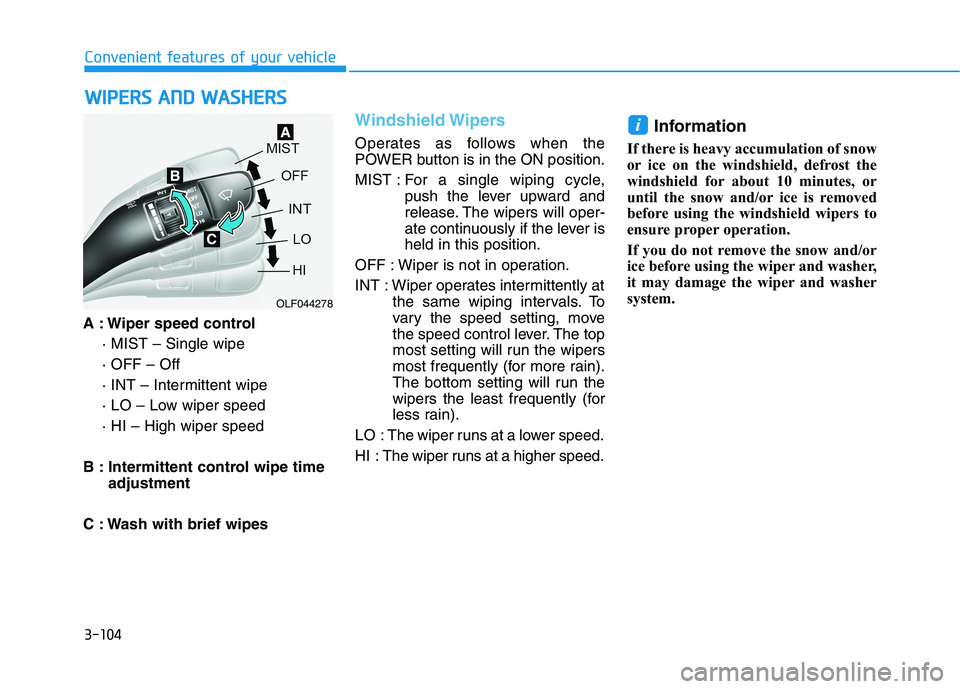
3-104
Convenient features of your vehicle
A : Wiper speed control· MIST – Single wipe · OFF – Off
· INT – Intermittent wipe
· LO – Low wiper speed· HI – High wiper speed
B : Intermittent control wipe time adjustment
C : Wash with brief wipes
Windshield Wipers
Operates as follows when the
POWER button is in the ON position.
MIST : For a single wiping cycle,
push the lever upward and
release. The wipers will oper-
ate continuously if the lever isheld in this position.
OFF : Wiper is not in operation.
INT : Wiper operates intermittently at the same wiping intervals. To
vary the speed setting, move
the speed control lever. The top
most setting will run the wipers
most frequently (for more rain).
The bottom setting will run the
wipers the least frequently (for
less rain).
LO : The wiper runs at a lower speed.
HI : The wiper runs at a higher speed. Information
If there is heavy accumulation of snow
or ice on the windshield, defrost the
windshield for about 10 minutes, or
until the snow and/or ice is removed
before using the windshield wipers to
ensure proper operation.
If you do not remove the snow and/or
ice before using the wiper and washer,
it may damage the wiper and washer
system.
i
WW IIPP EERR SS AA NN DD WW AASSHH EERR SS
OLF044278
Page 255 of 546
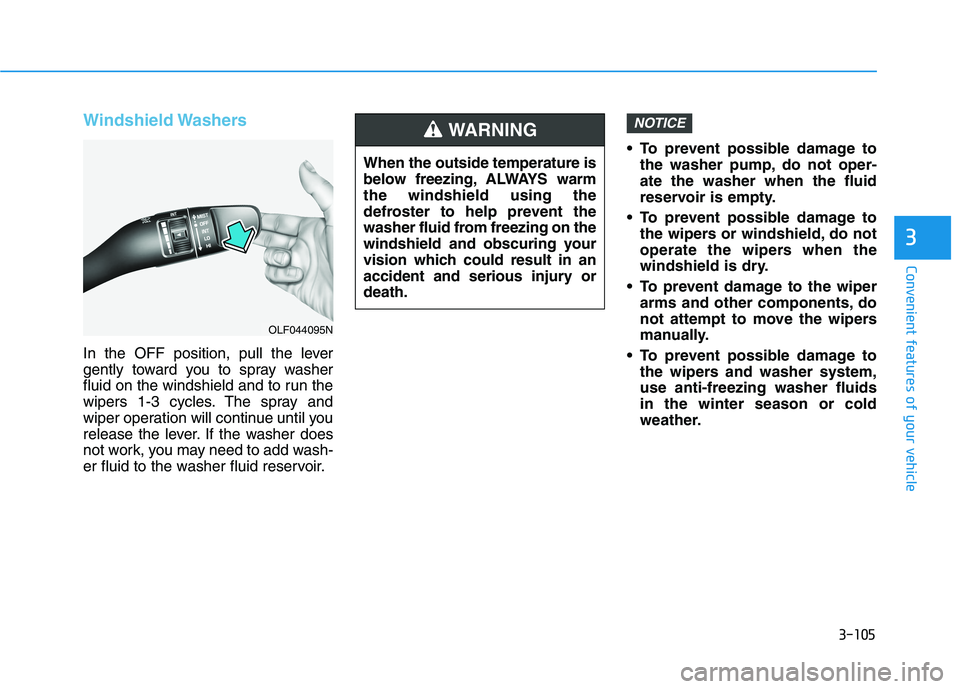
3-105
Convenient features of your vehicle
3
Windshield Washers
In the OFF position, pull the lever
gently toward you to spray washer
fluid on the windshield and to run the
wipers 1-3 cycles. The spray and
wiper operation will continue until you
release the lever. If the washer does
not work, you may need to add wash-
er fluid to the washer fluid reservoir. To prevent possible damage to
the washer pump, do not oper-ate the washer when the fluid
reservoir is empty.
To prevent possible damage to the wipers or windshield, do not
operate the wipers when the
windshield is dry.
To prevent damage to the wiper arms and other components, do
not attempt to move the wipers
manually.
To prevent possible damage to the wipers and washer system,use anti-freezing washer fluidsin the winter season or cold
weather.
NOTICE
When the outside temperature is
below freezing, ALWAYS warmthe windshield using the
defroster to help prevent the
washer fluid from freezing on the
windshield and obscuring your
vision which could result in an
accident and serious injury ordeath.
WARNING
OLF044095N
Page 476 of 546
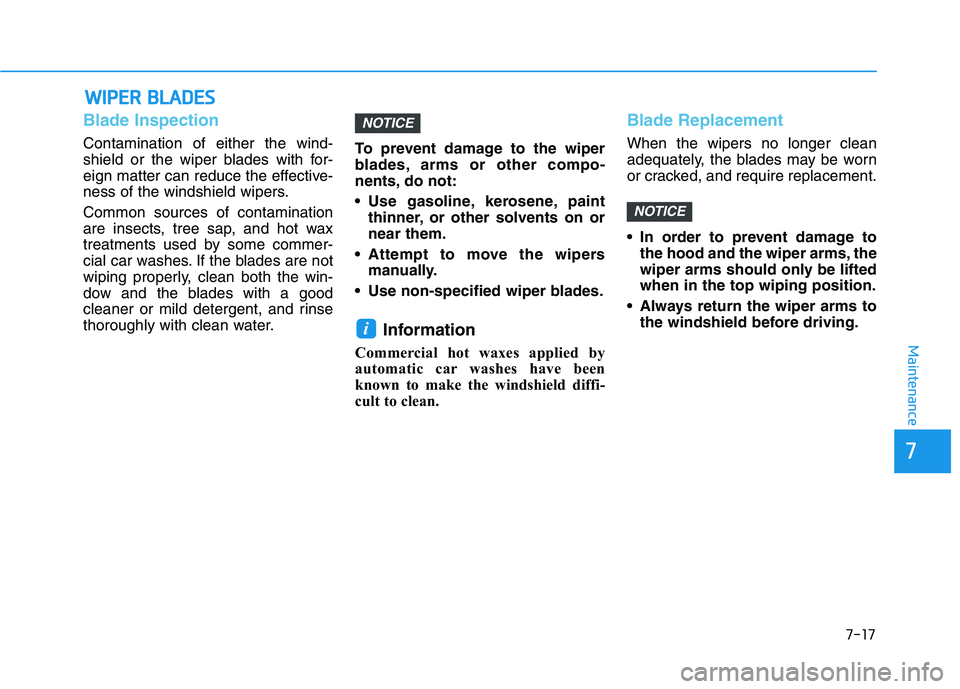
7-17
7
Maintenance
WWIIPP EERR BB LLAA DDEESS
Blade Inspection
Contamination of either the wind-
shield or the wiper blades with for-
eign matter can reduce the effective-
ness of the windshield wipers. Common sources of contamination
are insects, tree sap, and hot wax
treatments used by some commer-
cial car washes. If the blades are not
wiping properly, clean both the win-
dow and the blades with a good
cleaner or mild detergent, and rinse
thoroughly with clean water. To prevent damage to the wiper
blades, arms or other compo-
nents, do not:
Use gasoline, kerosene, paint
thinner, or other solvents on or near them.
Attempt to move the wipers manually.
Use non-specified wiper blades.
Information
Commercial hot waxes applied by
automatic car washes have been
known to make the windshield diffi-
cult to clean.
Blade Replacement
When the wipers no longer clean
adequately, the blades may be worn
or cracked, and require replacement.
In order to prevent damage to the hood and the wiper arms, the
wiper arms should only be liftedwhen in the top wiping position.
Always return the wiper arms to the windshield before driving.
NOTICE
i
NOTICE
Page 546 of 546
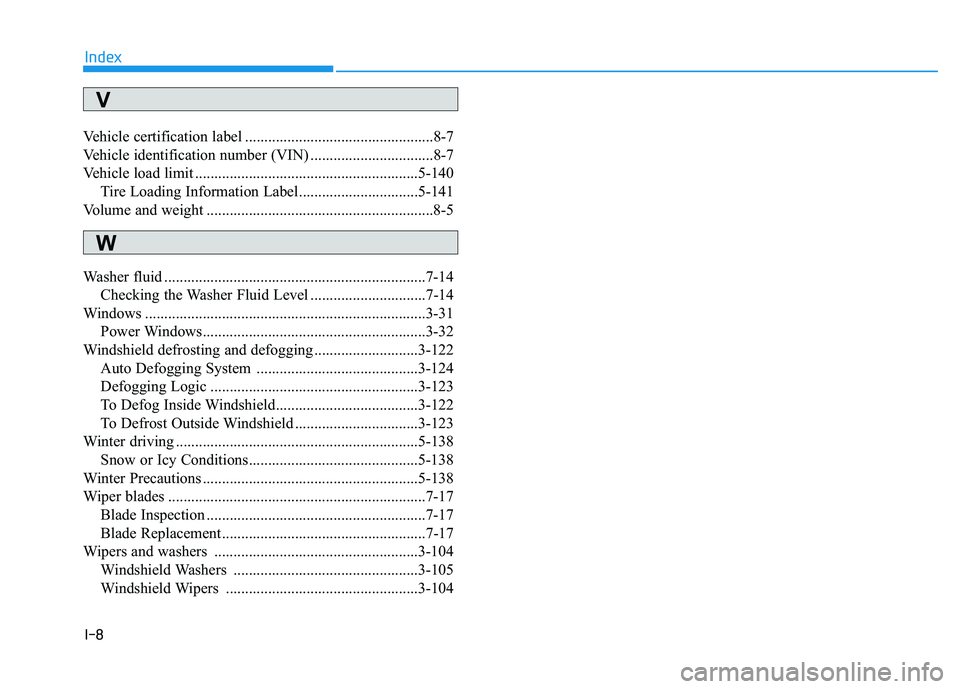
I-8
Vehicle certification label .................................................8-7
Vehicle identification number (VIN) ................................8-7
Vehicle load limit ..........................................................5-140
Tire Loading Information Label...............................5-141
Volume and weight ...........................................................8-5
Washer fluid ....................................................................7-14 Checking the Washer Fluid Level ..............................7-14
Windows .........................................................................3-31
Power Windows..........................................................3-32
Windshield defrosting and defogging ...........................3-122
Auto Defogging System ..........................................3-124
Defogging Logic ......................................................3-123
To Defog Inside Windshield.....................................3-122
To Defrost Outside Windshield ................................3-123
Winter driving ...............................................................5-138 Snow or Icy Conditions............................................5-138
Winter Precautions ........................................................5-138
Wiper blades ...................................................................7-17 Blade Inspection .........................................................7-17
Blade Replacement .....................................................7-17
Wipers and washers .....................................................3-104
Windshield Washers ................................................3-105
Windshield Wipers ..................................................3-104
Index
V
W